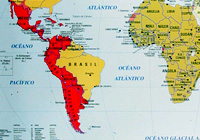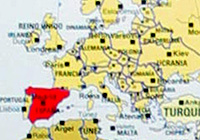Between 320 and 400 million people around the globe speaking Spanish as their first language and millions more as a second language. Spanish is one of the most widespread and significant languages of today's modern world.
Along with being an official language of countless international organizations, Spanish is the official language of 21 countries, including Spain and most of Latin America. Additionally, with the influx of immigration to the United States over the past few decades, the Spanish-speaking population is increasing exponentially.
Today, over 30 million people with five years and older speak Spanish at home, that's well over 10% of the U.S. population! But where is Spanish spoken as an official language?
Here you will find a list of countries where Spanish is spoken and you will be able to see some differences in vocabulary, because, although it is the same language, some words are unique to each country where Spanish is spoken.
Spanish-speaking countries
Spanish is a vibrant language that has been enriched over the centuries by influences from diverse cultures and regions. As Spanish spread around the world, each country adopted it and made it their own, adding their own touch and creating unique expressions.
Spanish is the official or co-language of the following countries:
- Spain
- Mexico
- Argentina
- Bolivia
- Chile
- Colombia
- Costa Rica
- Cuba
- Dominican Republic
- Ecuador
- El Salvador
- Guatemala
- Honduras
- Nicaragua
- Panama
- Paraguay
- Peru
- Puerto Rico
- Uruguay
- Venezuela
Spain: the cradle of the Spanish language
Let's start with the country where the language was born: Spain. Although the Spanish of Spain is considered the “standard Spanish”, this country also has its own linguistic peculiarities.
For example, while other Spanish-speaking countries say “banana”, Spain uses the term “plátano”. Even within Spain, there are places where the words are different. For example, in the Peninsula they say “autobús” (bus), while in the Canary Islands it is called “guagua”.


Mexico
In Mexico, Spanish is mixed with a rich culinary tradition. Here, don't be surprised if you hear people talk about “chiles” instead of “pimientos” (pepper), or if they offer you “elote” instead of “mazorca de maíz” (ear of corn). Food is a fundamental part of Mexican culture, and the language reflects this passion for cooking.
Argentina
Argentina is famous for its special language called "lunfardo", which incorporates words and expressions of Italian and Creole origin. If you visit Buenos Aires, you are likely to hear people talking about “laburar” (to work) or “guita” (money).
Argentines have a particular accent that will make you fall in love with them and allow you to differentiate it from other countries where Spanish is spoken. Also, in Argentina they use the word “vos” instead of “tú” (you) when they speak.
Colombia
The Colombian accent is known for its musical and friendly tone. If you visit Colombia, you might hear people talking about 'plata' instead of 'dinero'. Also, their accent is very distinctive and you're sure to hear it from soap operas such as “Pasión de Gavilanes”.
Peru
Peru is a country with a rich indigenous heritage, and this influence is reflected in its language. Here, it is common to hear people talk about 'chompa' when referring to a jumper.
Countries where Spanish is spoken, but is not an official language
Spanish is also spoken in several countries and regions because of historical and cultural influence. These places are:
- United States: Spanish is widely spoken in areas with significant Hispanic populations, such as Texas, Florida and California.
- Philippines: although not an official language, Spanish has a historical influence on the Filipino language.
- Western Sahara or Equatorial Guinea: Spanish is spoken in this region due to Spanish colonial history.
Spanish-speaking countries are diverse and exciting places, each bringing its own essence to Spanish language. Exploring these differences in vocabulary and accent is part of the fun of learning this beautiful language.
If you're determined to improve your Spanish, or if you just fancy immersing yourself in different cultures, take an intensive Spanish course with Enforex. You can choose from 11 different destinations in Spain and from 9 countries in Latin America where Spanish is spoken as an official language.
- Why Learn Spanish?
- Spanish Variations & Dialects


